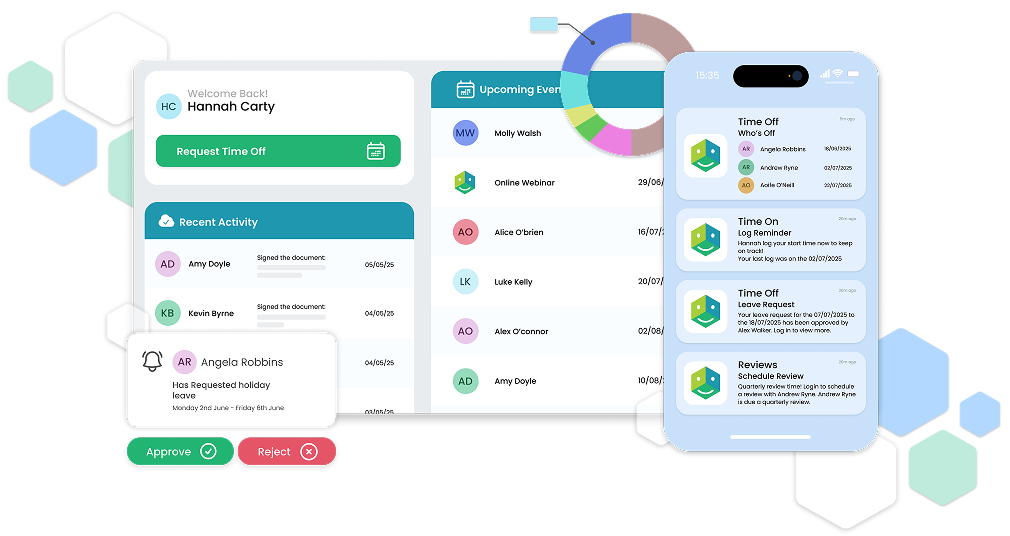Employees in Ireland now have the right to request remote work. But do you have the resources, infrastructure, and technology to support it?
If you can’t answer that question just yet, it’s time to do the work. Employees must submit requests for remote work at least eight weeks in advance of the intended start date. But employers must respond to these requests within four weeks – which isn’t much time to prepare.
With that in mind, here are some things you should focus on ahead of remote working requests.
What’s Your Strategy?
Before you sign off on any remote work requests, it’s vital that you lay the groundwork. Having a specific remote work policy is crucial, especially when it comes to standardising your remote work approach.
Here are some of the elements you should include:
- Eligibility criteria, as specified by the government, require employees to have at least six months of service.
- Guidance on setting up a secure, safe, and healthy remote work environment. Check out the HRLocker Remote Working – Health and Safety Checklist to ensure everything runs smoothly.
- Tools, equipment, and supplies. Consider what staff will need to do their jobs remotely, and assess what you can or can't supply to meet these needs.
- Core working hours, attendance, and time-tracking specifications all need to be taken into consideration.
- Preferred communication channels for you and your remote workers to keep in touch.
- Remote work options include whether employees have to work from home, or if they can do so while travelling, or in coworking spaces.
- Any legal requirements pay particular attention to any laws and regulations that need to be met.
- Tax allowances for remote working and any other financial stipend you may choose to provide.
If you’re using HR software, add this policy to the employee portal so that individuals can return to it at a later date. Once you have a policy in place, be sure to update your employee handbook and safety statement.
Communicating the specifics of your remote work policy and approach is essential. Make sure you use all the platforms available to you, such as employee HR portals, internal emails, and team meetings, where you can field questions and respond to individual needs.
Where requests for remote work have been accepted, you should also consider updating or reissuing employment contracts. This is easier to manage if you have HR software in place that facilitates document sharing. You can make changes in the system and manage signatures and sign-off in one place.
Do You Have the Right Tools and Tech in Place?
Remote work doesn’t work if you’re still dependent on pen and paper. Having the digital tools, processes, and infrastructure in place to support remote work is just as important as having a place to work.

First of all, you’ll need a knowledge hub. This is a cloud-based location where employees can access resources and tools relating to their jobs, wherever they’re based. For many, this is as simple as using Microsoft 365 or Google Drive to store and share information.
You may also need to upgrade your communication channels. If you’ve relied on office osmosis in the past, that won’t do for remote workers. Establish clear channels for communication, and be sure to cover asynchronous (instant messaging or email) and synchronous (video calls or in-person meetups) methods.
Spend some time considering your security approach, too. It’s much easier to manage devices tied to a specific location, and implementing remote work might require you to invest in additional security software to protect individuals and the company. Be specific about where and how company devices can be used, and if employees are using personal devices for work purposes, make sure you offer guidance here too.
In your quest to support remote workers, don’t miss the obvious: giving employees access to the tech and tools they need to do their jobs. Set up accounts, log-ins, and profiles before your employees start remote working – so time isn’t wasted on chasing up access.
Are You Protecting Connections?
Remote workers aren’t antisocial!
There are countless reasons why people may choose remote work over office-based work. For some people, remote work is more accessible. It allows them to manage a chronic illness or disability, supports parents who need to balance work and childcare, and may be the preference for neurodivergent people who require specific environmental adjustments.
But that’s not to say you should stop socialising and connecting with teams in person. One option is to have a quarterly away day or social event where individuals can reaffirm bonds with their colleagues. Some remote-first companies set up ‘workation’ trips, where colleagues come together for socialising, strategising, and team-building activities.
These events don’t have to be grandiose. A team lunch and in-person coworking sessions every month can be enough to help colleagues connect. It takes time for individuals to adjust to remote working, so making sure there’s support in place and opportunities to strengthen social bonds is key.
Give serious thought to employee wellbeing, too. Remote working can be isolating if individuals don’t have systems and support in place. You could assign a remote work wellbeing ambassador to check in with individuals who’ve adopted remote work. Support with building daily schedules and managing workloads should also be provided since it can be difficult to establish if people are overworking when they’re not physically present.
Don’t be disheartened if remote work doesn’t work for your company immediately. It takes time and heaps of trust to make distributed teams effective. Keep checking in with your employees, and take inspiration from the companies adopting a remote-first approach successfully. If you want to secure the best talent and provide for your people’s unique needs, offering remote work can be a positive step towards that.
For more help with generating a remote work strategy, check out the government’s remote working checklist.










